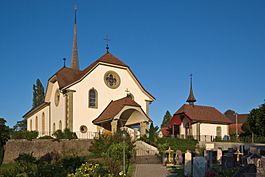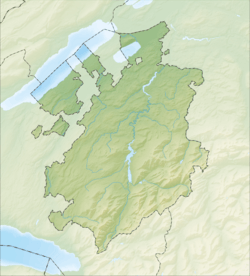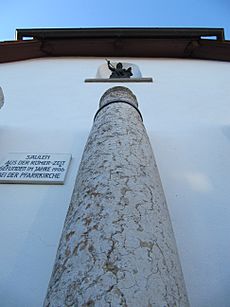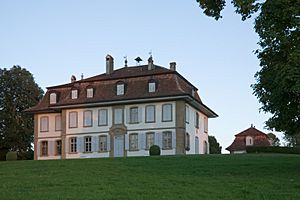Bösingen, Fribourg facts for kids
Quick facts for kids
Bösingen
|
||
|---|---|---|

St. Jakob church, Bösingen
|
||
|
||
| Country | Switzerland | |
| Canton | Fribourg | |
| District | Sense | |
| Area | ||
| • Total | 14.33 km2 (5.53 sq mi) | |
| Elevation | 550 m (1,800 ft) | |
| Population
(Dec 2020 )
|
||
| • Total | 3,421 | |
| • Density | 238.73/km2 (618.31/sq mi) | |
| Postal code |
3178
|
|
| Surrounded by | Düdingen, Kleinbösingen, Kriechenwil (BE), Laupen (BE), Neuenegg (BE), Schmitten, Wünnewil-Flamatt | |
Bösingen is a municipality, which is like a small town or district, located in the Sense district of Fribourg in Switzerland. It's special because most people here speak German, even though the Fribourg canton mostly speaks French.
Contents
A Look at Bösingen's Past
Bösingen has a long history! It was first mentioned way back in 1228. Back then, it was called Basens. For a while, it was also known by its French name, Bésingue, but that name isn't used anymore. Between 1953 and 1962, it even had a different name: Grossbösingen.
Exploring Bösingen's Geography
Bösingen covers an area of about 14.32 square kilometers (around 5.5 square miles). A big part of this land, about 75%, is used for farming. This means there are lots of fields and pastures.
About 15% of the area is covered by forests. The rest of the land, about 9%, has buildings and roads. A small part, less than 1%, is made up of rivers.
Bösingen is located in the Sense district. It includes the main village of Bösingen, which is a haufendorf village. This means it's an irregular, unplanned village with buildings packed closely together around a central area. There are also many smaller areas called hamlets scattered around, like Fendringen, Grenchen, and Richterwil.
What Does Bösingen's Coat of Arms Mean?
Every town has a special symbol called a coat of arms. Bösingen's coat of arms has a black horse head on a gold background at the top. Below that, on a red background, there's a golden harrow (a farm tool) between two golden scallop shells. These symbols tell a story about the town's history and what's important to its people.
Who Lives in Bösingen?
Bösingen has a population of about 3,400 people. Over the past ten years, the number of people living here has grown by about 6%. This growth is partly because new people have moved in and partly because more babies are born than people pass away.
Most people in Bösingen, about 93%, speak German as their main language. Some people also speak Italian or French.
In 2008, about half of the population was male and half was female. Most residents were Swiss citizens. About 35% of the people living in Bösingen in 2000 were actually born there. Many others were born in the same canton or elsewhere in Switzerland.
- About 29% of the population are children and teenagers (under 20 years old).
- About 62% are adults (20-64 years old).
- About 8% are seniors (over 64 years old).
In 2000, there were about 1,128 homes in Bösingen, with an average of 2.7 people living in each. Most of the apartments were lived in all year round.
The chart below shows how Bösingen's population has changed over many years:

Important Historical Sites
Bösingen has some very important historical places! A complex from the Gallo-Roman period (when Romans lived in Gaul, which is now France and parts of Switzerland) and the Vogelshus country estate are listed as Swiss heritage sites of national importance. This means they are very special and protected. The entire village of Bösingen and the hamlet of Richterwil are also part of the Inventory of Swiss Heritage Sites, showing their historical value.
How People Work and Earn a Living
In 2010, Bösingen had a low unemployment rate, meaning most people who wanted jobs had them. Many people work in different areas:
- Primary sector: This includes jobs like farming.
- Secondary sector: This includes jobs in manufacturing (making things) and construction (building things).
- Tertiary sector: This includes jobs in services, like sales, transportation, hotels, restaurants, and education.
Many people who live in Bösingen travel to other towns for work. About 18% of working people use public transportation, like buses or trains, to get to their jobs. Most people, about 59%, use a private car.
Religious Life in Bösingen
In 2000, about 53% of the people in Bösingen were Roman Catholic. About 33% belonged to the Swiss Reformed Church, which is a Protestant church. There were also smaller groups of people who belonged to other Christian churches, or were Muslim, Buddhist, or Hindu. Some people did not belong to any church.
Learning and Education
Education is important in Bösingen! Many adults, about 40%, have finished high school. About 11% have gone on to higher education, like a university or a special college called a Fachhochschule.
The school system in Fribourg canton works like this:
- One year of optional Kindergarten.
- Six years of Primary school.
- Three years of required lower Secondary school, where students are grouped by their abilities.
- After that, students can choose to go to a three or four-year upper Secondary school. This can be a gymnasium (which prepares you for university) or a vocational program (which teaches you skills for a specific job).
- After upper Secondary, students can go to a higher college or start an apprenticeship (learning a trade on the job).
In the 2010-2011 school year, Bösingen had 243 students in 13 classes. Many students from Bösingen also attended schools in nearby towns, especially for secondary and higher education.
Notable People from Bösingen
Bösingen has been home to some interesting people:
- Heinrich Schnyder (1897–1974), who was an expert in farming and a politician.
- Oliver Schaller (*1994), a talented badminton player.
- Yannik Zechner (*2005), a songwriter.
Images for kids
See also
 In Spanish: Bösingen para niños
In Spanish: Bösingen para niños







